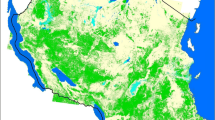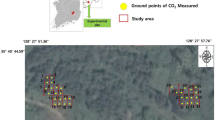Abstract
Credible measurement, reporting and verification (MRV) for carbon stock are among the most critical elements for the successful implementation of any forestry carbon trading. However, it is very hard to get quantitative evidence validating carbon stock difference among project area (PA), leakage management area and leakage belt (LB) at this moment. Accordingly, this study is intended to contrast OCO-2 XCO2 signature between REDD+ project area and nearby LB. The XCO2 in individual land cover have kept decreasing after the implementation of REDD+ project. The natural forest and woodland which is dominant land use and land cover type shows positive evidences achieved by the REDD project by presenting the lowest XCO2 signature (natural forest: 394.1 ppm, woodland: 393.2 ppm) and highest NDVI (natural forest: 0.498, woodland: 0.488) in PA. It is anticipated that this research outcome could be used as a valuable reference toward MRV based-on OCO-2 XCO2 in relation to performance evaluation of forest carbon trading.






Similar content being viewed by others
Notes
Landsat 7 image is an image gap-filled through the Focal Analysis function of Erdas Imagine 9.2.
Deforestation via different forms of payoffs has strong relations , i.e., (1) allocating ‘underdeveloped’ land such as forest to landless individuals to settle and farm; (2) allowing (legal or illegal) deforestation activities of large-scale agriculture firms; and (3) increasing agricultural credit for farmers so that they can expand their agriculture land into forest areas.
https://cdm.unfccc.int/Projects/projsearch.html (accessed on 30 July 2017).
References
Angelsen, A. (2008). Moving ahead with REDD: Issues, options and implications. Bogor: CIFOR (Center for International Forest Research).
Fearnside, P. M. (2009). Carbon benefits from Amazonian forest reserves: leakage accounting and the value of time. Mitigation and Adaptation Strategies for Global Change, 14(6), 557–567. doi:10.1007/s11027-009-9174-9.
Atmadja, S., & Verchot, L. (2012). A review of the state of research, policies and strategies in addressing leakage from reducing emissions from deforestation and forest degradation (REDD+). Mitigation and Adaptation Strategies for Global Change, 17(3), 311–336. doi:10.1007/s11027-011-9328-4.
Hwang, Y., & Um, J.-S. (2017). Exploring causal relationship between landforms and ground level CO2 in Dalseong forestry carbon project site of South Korea. Spatial Information Research, 25(3), 361–370. doi:10.1007/s41324-017-0103-9.
Hwang, Y., & Um, J.-S. (2016). Performance evaluation of OCO-2 XCO2 signatures in exploring casual relationship between CO2 emission and land cover. Spatial Information Research, 24(4), 451–461. doi:10.1007/s41324-016-0044-8.
Hwang, Y., & Um, J.-S. (2016). Comparative evaluation of XCO2 concentration among climate types within India region using OCO-2 signatures. Spatial Information Research, 24(6), 679–688. doi:10.1007/s41324-016-0063-5.
Hwang, Y., & Um, J.-S. (2016). Evaluating co-relationship between OCO-2 XCO2 and in situ CO2 measured with portable equipment in Seoul. Spatial Information Research, 24(5), 565–575. doi:10.1007/s41324-016-0053-7.
Saatchi, S. S., Harris, N. L., Brown, S., Lefsky, M., Mitchard, E. T. A., Salas, W., et al. (2011). Benchmark map of forest carbon stocks in tropical regions across three continents. Proceedings of the National Academy of Sciences, 108(24), 9899–9904. doi:10.1073/pnas.1019576108.
Watson, C., Mourato, S., & Milner-Gulland, E. J. (2013). Uncertain emission reductions from forest conservation: REDD in the Bale Mountains, Ethiopia. Ecology and Society. doi:10.5751/ES-05670-180306.
Yimer, F., Ledin, S., & Abdelkadir, A. (2006). Soil organic carbon and total nitrogen stocks as affected by topographic aspect and vegetation in the Bale Mountains, Ethiopia. Geoderma, 135, 335–344. doi:10.1016/j.geoderma.2006.01.005.
Teshome, E., Randall, D., & Kinahan, A. (2011). The changing face of the Bale Mountains National Park over 32 years: A study of land cover change. Walia-Special Edition on the Bale Mountains, 2011(2), 118–130.
Hailemariam, S. N., Soromessa, T., & Teketay, D. (2016). Land use and land cover change in the Bale Mountain Eco-Region of Ethiopia during 1985 to 2015. Land, 5(4), 41. doi:10.3390/land5040041.
Siraj, M., Zhang, K., Xiao, W., Bilal, A., Gemechu, S., Geda, K., et al. (2016). Does participatory forest management save the remnant forest in Ethiopia? Proceedings of the National Academy of Sciences, India Section B: Biological Sciences. doi:10.1007/s40011-016-0712-4.
OFWE. (2015). Bale mountains eco-region reduction of emission from deforestation and forest degradation (REDD+) project (ver.3.4). Addis Ababa: Oromia Forest and Wildlife Enterprise.
Park, S.-I., Hwang, Y., & Um, J.-S. (2017). Utilizing OCO-2 satellite transect in comparing XCO2 concentrations among administrative regions in Northeast Asia. Spatial Information Research, 25(3), 459–466. doi:10.1007/s41324-017-0111-9.
Um, J. S. (2015). Comparative evaluation of CO2 concentrations across administrative regions with temperate climates in Northeast Asia: Potentials and constraints. Carbon Management, 6(3–4), 89–99. doi:10.1080/17583004.2015.1090057.
Nune, S., Soromessa, T., & Teketay, D. (2015). Non-carbon benefits for effective implementation of REDD+: The case of Bale Mountains Eco-Region, Southeastern Ethiopian. African Journal of Environmental Science and Technology, 9, 747–764. doi:10.5897/AJEST2015.1953.
Acknowledgements
This research was supported by Basic Science Research Program through the National Research Foundation of Korea (NRF) funded by the Ministry of Education (NRF2015R1D1A1A01056801). We thank National Aeronautics and Space Administration, United States (NASA) for providing OCO-2 satellite data.
Author information
Authors and Affiliations
Corresponding author
Rights and permissions
About this article
Cite this article
Hwang, Y., Um, JS. Comparative evaluation of OCO-2 XCO2 signature between REDD+ project area and nearby leakage belt. Spat. Inf. Res. 25, 693–700 (2017). https://doi.org/10.1007/s41324-017-0136-0
Received:
Revised:
Accepted:
Published:
Issue Date:
DOI: https://doi.org/10.1007/s41324-017-0136-0




